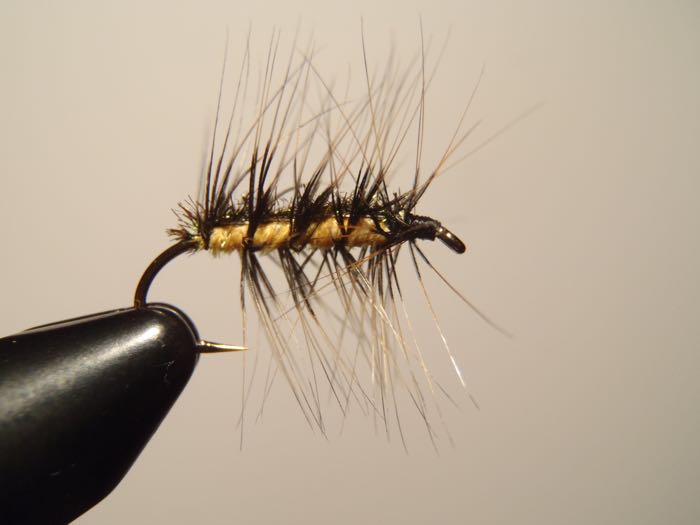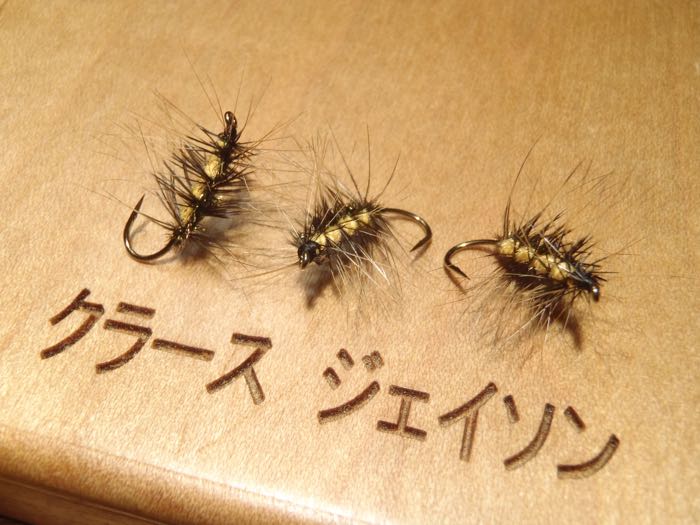
Although I mostly fish sakasa kebari now, every once in a while, I rediscover a pattern from my pre-tenkara days that I think is perfect for tenkara in its ethos. I recently remembered a somewhat esoteric one I used to consider a staple when I was only western fly fishing: the FC Crackleback.
Think of the Crackleback as a diminutive Woolly Worm with a shellback of peacock herl. It was invented in the early 50s by legendary angler and founder of Feather-Craft, Ed Story.
Why is it good and why is it good for tenkara?
- It’s simple and easy to tie. As with many tenkara patterns, this means you can tie a lot of them and toss your fly into the precarious lairs where you just know trout are hiding, but also know you run a high risk of losing your fly. In other words, they’re expendable. And that gives you an advantage over the reluctant angler that would never consider potentially sacrificing their $4 Royal Coachman to that fishy looking log jam.
- It’s versatile. Not only is it nondescript enough to represent anything and just plain “buggy”, you can fish the Crackleback as a dry in a dead drift, let it sink as a nymph in a dead drift, swing it, skate in on or just below the surface, or pulse it. And it can be fished upstream or downstream. You can present it all of these ways without having to switch patterns, meaning you spend more time with your fly in the water than sifting through your fly box and vest pockets (and we know what that translates to).
- It’s a chameleon. As you’ll see in the video below, Ed’s original recipe called for a shellback of peacock herl, a body of white turkey flat, and a palmered furnace hackle. But this fly lends itself to much experimentation with different colors and materials. For example, you could use yarn, dubbing, ostrich herl, floss, chenille, or even tinsel or pearl Mylar for the body. You could use Grizzly hackle or any other color for the palmer. You could even experiment with different colored threads for the head or add a tag or tail. The possibilities are nearly infinite. This is one pattern that will allow you to be a mad scientist at the vise.
Ed’s original recipe
Now, here’s the video I promised with Ed himself showing you the original tie from 1952. As you will see in my pictures, I stick pretty close to it, although I prefer yellow turkey for the body, and sometimes tie them on a 2X-long nymph hook instead of a dry fly hook …
If you don’t tie, don’t fret. You can purchase them here in a variety of colors and at a great price. Sadly, Ed passed away in 2008, but luckily for the rest of us, the great fly fishing supplier he created still lives on. Ed missed the whole tenkara revolution in this country by a mere year. But having experienced his progeny of the Crackleback, I think he would have embraced it. Through it, he left a great gift behind for both tenkara and non-tenkara angler alike.









I did my first trout fishing in Missouri. Cracklebacks were great on some of the trout wters there. We’d fish them as a dry, and then at the end of the drift let them swing. I caught my biggest browm on the Niangua river that way. People would also “skip” them, which was basically pulsing. I’ve ofter said that conceptually, this was the closest western fly I knew of to some of the Japanese patterns. May need to give them another try soon. 🙂
John – I’m not sure if you still fish in Missouri, but the crackleback is still a favorite at the trout parks. Many anglers fish them with a sinking line. I like them for trout and panfish.
What you aldo can do is cut the hacklefibres away. But just the top and bottom ones. Leave the side-hackle fibres on. Then you got a real effective fly that sits partly in the surface. In norway they call it supperpuppa
Nice tip Chris!
Nice Job Jason. I’m going to add these to my fly box and see how they work for my clients!
I like it. It ‘shouts’ midge. I can see me tying them in sizes down to #24 .
Thanks for bringing it to my attention. Never heard of it before but then I do live in the UK.
PS. I am a huge fan of ‘Tenkaratalk’
They’re also extremely effective during a Trico hatch… Been using them and similar ties on the Missouri River MT to imitate Trico clusters for well over 20 years…
Most Missouri fly fisherman I know carry an assortment of cracklebacks in their fly box – as stated above, it’s an extremely versatile fly. I use a bead head version for nymphing in deeper water, which I get from an online outfit called Midwestflies.com.
Jason, having had the privilege of knowing Mr. Story, and fishing the Crackleback, not only here in Missouri, but all over the country, I can say that if I could only use one fly pattern, it would be the Crackleback. I also have the convienience, since I live in St. Louis, to be able to shop at the Feathercraft Store on Manchester Road. Great products, and knowledgeable employees always make a unique experience of shopping there. A must stop along with Hargroves Fly Shop if you are in the St. Louis area.
Good all around fly! Great recommendation Jason!
I’ve had very good success fishing a somewhat similar kebari. I just call them my “ugly rumpled kebari”. I use them because I lean toward believing fish are attracted more to ugly kebari, they may appear more like wounded prey battered by river currents to the fish.
In early summer green thread body with ginger colored hackle have worked well. Sometimes the hackle fairly thick, others very sparse. I lean toward preferring very sparse. Or thicker on one end & sparser on the other end, random really. The more chaotic the hackle sticks out in random directions the better.
Other variations I use are brown or camel colored thread or black thread or even yarn. Some with black/white saddle hackle or white hackle if using a dark body color. Thus they a little simpler to tie than the Crackle Back, using just 2 materials. In many ways very similar to the Kurobe head stream area kebari on the Yoshikazu Fujioka web site. The ones I tie tend to be more like the Bunpei Sonehara kebar in overall shape (but often sparser hackle – closer to the kebari on the left on the below web-page, except I may use a brighter body color), sometimes I leave that tail on, sometimes not. Generally on size 12 hooks, but also sizes 14, 10 or 8.
http://www.hi-ho.ne.jp/amago/b-streams/flytying/tenkara.html .
You should break out of the sakasa kebari box. Other patterns are traditional Japanese Tenkara kebari patterns, and also very effective. imo.
D
David, as always, awesome and insightful comment. I always appreciate your in-depth comments! I have tried traditional Japanese patterns other than sakasa kebari and am a big fan of Fujioka’s site. If you remember, I did an interview with him here.
I’ve also blended Western patterns with Japanese and have experimented with all kinds of interpretations. I guess I settled on the sakasa kebari because it just proved to be so effective.
Now, I think if there’s any “box” I need to think outside of (ironically) it’s getting back to my roots in my pre-tenkara days. For no apparent reason, I’ve pretty much resisted fishing my western standbys with tenkara, but that’s going to change this season. I’m actively filling a box with all my favorite patterns from earlier in my fly fishing career and am going to make an effort to resurrect them in the spring. Seems like I can’t go wrong … confidence patterns + confidence technique, right? We’ll see.
The Crackleback is just what you state, an awesome, versatile fly and trust me it’s a worthy addition to your tenkara box!!! I fish a lot in Missouri but also elsewhere and it will always pull up some fish.
Showed up at my favorite spot only to find I had left all my dries at home. Luckily I found a small altoids tin with a few flies in it that someone had given me a while back. I tied on a yellow and black crackle back and proceeded to fish that thing until it came unraveled. I fished two more crackle backs down to the hook and had one of my best days at this spot. I came upon this fly by mistake but it is most definitely a must have tenkara fly for me now! I’m glad I know the name of it now!
btw, Ed Story had a real talent for describing how he tied this fly. Might be the clearest description I’ve ever seen about how to tie any fly. (I wasn’t familiar with him. Sad to say I see he passed away in 2008). Good tying technique that could be used for tying other variations.
Here’s a PDF document showing how it’s tied. Easy to save it to your smart phone or iPad, etc. To help recall how to tie it later. In these instructions they used turkey quills dyed green.
http://www.foxvalleytu.org/Duane%20Velie%20Folder/Recipes/Crackleback.pdf .
Nothing wrong with using flies that have proven effective on our streams with our species of fish.
And experimenting with how they can be fished most effectively with tenkara hardware, and techniques. Or developing new tenkara techniques using them.
After all if you look at a half dozen Japanese tenkara masters that are known here they each have their own style, methods, and preferred fly pattern. I’ve been kind of surprised at how popular parachute flies are on many Japanese tenkara websites.
Daiwa offers them on the tenkara section of their website. Probably a favorite pattern of Etsuji Katayama (悦二片山), Daiwa’s field tester & developer of their level line rods and lines. His other favorite being what I would call a jun-kebari (順毛鉤) or futsu-kebari (普通毛鉤), rather than a sakasa kebari (逆さ毛鉤). Apparently a pattern he developed.
See
http://www.daiwaweb.com/jp/fishing/item/terminal_tackle/keiryu_te/tenkara_kebariset/index.html .
Anyway, I’ll be trying the Crackleback next fishing season.
I had completely forgotten about these. They were the second fly I learned how to tie when i first started back in the early 80’s, after the wooly bugger. There were summers where this was the only fly I ever fished because I couldn’t afford to buy any other tying materials. This was decades before I knew about the one-fly theory practiced by some in tenkara today.
Thanks for the memories Jason. I’ll definitely be adding these back into my rotation next season.
I fish these all the time. I’m lucky to live less than half a mile from the shop and got turned into them before I even hit the water. Great staff and product selection!
The Crackleback is a truely amazing fly !
There are unlimited variations in both the body materials from the original turkey flats to dubbing materials like snowshoe rabbit. Another effective body is holographic tensile in various colors. The hackle can be in any number of colors too.
My latest trial in body materials has been with CDC which brings a new element of life to the fly. I’ve found it to create a real slayer of trout ! Give it it try.
Thank You Ed Story for this wonderful creation !
Does this answer your questions?